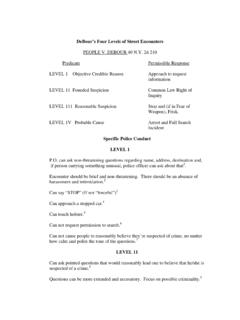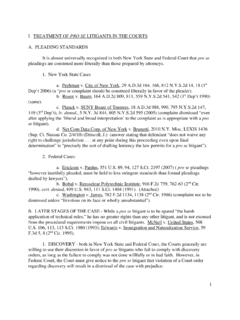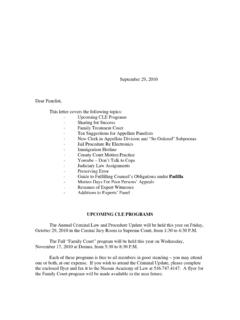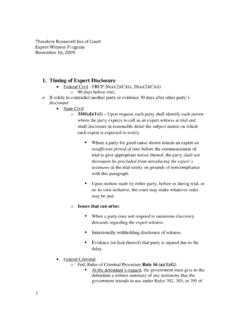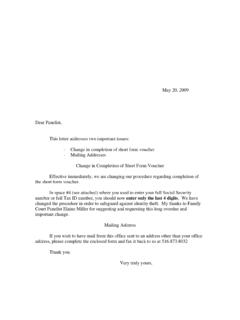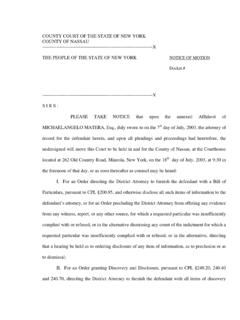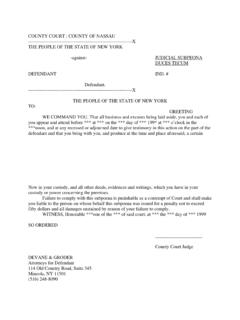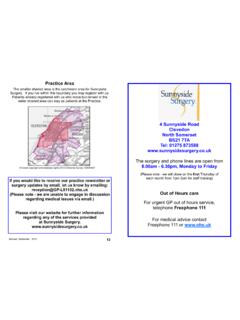Transcription of By Patrick L. McCloskey - nassau18b.org
1 Street Encounters Made Simple By Patrick L. McCloskey The leading New York case on street encounters is People v. De Bour1, where the Court of Appeals set forth four levels of permissible police conduct when confronting individuals on the street. Level 1 deals with a police officer who has an objective credible reason to approach someone. If a police officer has such a reason, De Bour says he may approach that person to request information. Level 2 involves a founded suspicion regarding a person. If a police officer has a founded suspicion, he may engage that person in the common law right of inquiry. Level 3 deals with a police officer who has a reasonable suspicion regarding an individual. In such case, the police officer may forcibly stop such person and if the police officer is in fear of weapons, may frisk the person for such weapons.
2 Level 4 deals with a police officer who has probable cause regarding a person. If a police officer has probable cause, he may arrest and search such person. The foregoing rules are easily listed but not so easily applied. The dynamics of street encounters are such that a police officer may have a founded suspicion (Level 2) and then, because of something the defendant does, ( reach to his waistband) the police officer may be at Level 3 in an instant. It also frequently happens that a police officer will approach a person with, eg, a Level 2 predicate (founded suspicion) but will engage in Level 3 conduct (forcible stop). If that happens, ie, if the police officer s conduct exceeds his predicate, such conduct is unreasonable and any evidence seized thereafter will be suppressed. For these reasons, it is important to know exactly what constitutes the 4 levels of predicate information and exactly what police conduct is permitted at each level.
3 Here goes. Level 1: An objective credible reason is virtually any reason a police officer can articulate that would lead a reasonable person to believe that his purpose in approaching an individual is not based upon an illicit motive. A Level 1 encounter may involve criminality but may also involve the police public service function2. At Level 1, a police officer may approach a car at a red light or an individual on the A police officer may ask non-threatening questions regarding a person s name, address and Depending upon the police officer s tone of voice, he may say Stop .5 If the person is carrying something unusual ( a television set in a pillowcase), the police officer may ask about If the person is carrying something not unusual ( a briefcase or a knapsack) the police officer should not ask about A Level 1 encounter should be brief and non-threatening. There should be an absence of harassment and No matter how calm and polite the tone of the questions, the police officer may not cause the individual to reasonably believe that he is suspected of Most importantly, the police officer may not request the person s permission to Even if an otherwise valid consent to such a request is granted, the fruits of the resultant search will be Level 2: A founded suspicion involves criminality but is difficult to pin down.
4 I suggest that if a police officer can articulate a good faith reason to believe that he suspects a particular person of criminal activity (something beyond a mere hunch or police intuition) he has a founded suspicion. In addition, it is clear that if a police officer receives an anonymous tip about a person s criminality and goes to the designated location and sees such a person, he has a founded At Level 2, a police officer can ask pointed questions that would reasonably lead one to believe that he is suspected of crime. The questions can be more extended and They may and usually do focus on criminality. A police officer may request permission to search at Level 214, but he cannot forcibly detain the Finally, because pursuit has been held to be the equivalent of seizure in New York State16, a police officer may not pursue a person if he is only at Level 2. Level 3: Whenever a police officer observes unusual conduct that leads him reasonably to conclude that criminality may be afoot, he has reasonable Further, if a reliable confidential informant, who does not give his basis of knowledge to a police officer, advises the police officer as to an individual involved in criminality at a given location, and if the police officer confirms that such a person is present at the location, he has reasonable Finally, if an anonymous tipster gives the police information about a person s criminality, including a prediction about such person s future behavior, and if the police go to the designated location and corroborate non criminal detail about such person and then further corroborate the predicated future behavior of such person ( that he moved from point A to point B)
5 They have reasonable If the police have reasonable suspicion, they may approach a person on the street or may pull a single moving car out of the flow of They may forcibly detain such They may frisk such person for weapons if they are in fear for their safety, but they may not frisk for For good reason in a particular circumstance, they may order a person to lie on the ground23 or handcuff a They may Level 4: Probable cause is information sufficient to warrant a person of reasonable caution in the belief that the defendant has committed a crime, or that the fruits, evidence or instrumentalities of crime can be found at a given location. If a police officer has probable cause with respect to an individual, he may arrest that person on the street without an arrest warrant26 and he may search him incident to arrest without a search A final word about pursuit is necessary. Since pursuit is the equivalent of a seizure in New York State, it is permitted only at Level 3 or 4.
6 The tricky part is that pursuit goes hand in hand with a defendant s flight and, generally speaking, if a defendant flees while the police are engaging him in a street encounter, the flight will raise the police predicate to the next higher level. Thus if the police are at Level 1 and the defendant flees, they will be at Level 2. At Level 2 they may not pursue If they are at Level 2, however, and the defendant flees, they may pursue him, not because they can pursue at Level 2, but because Level 2 plus flight will put the police at Level 3, where pursuit is This area is murky because in at least three cases30, the Court of Appeals has seemingly said that Level 1 plus flight equals Level 3. It is submitted, however, that a reading of those three cases reveals facts that clearly placed the police at Level 2 before the defendant fled. I hope the foregoing is useful to both my prosecutorial and defense friends. In any event, that s my story about street encounters and I m sticking to it.
7 1 40 2d 210 2 As the De Bour court noted: No one would quarrel with a police officer s right to make inquiry of passers-by to find the parents of a lost child. Id, at 218 3 People v. Ocasio 85 2d 982 People v. Harrison 57 2d 470 4 People v. Hollman 79 2d 181 at 185 5 People v. Bora 83 2d 531 6 Hollman at 191 7 Id 8 Id at 190 191 9 Id at 185 10 Id at 191-192 11 Id at 194 12 People v. Stewart 41 2d 65 at 69 13 Hollman at 191 14 Id at 191-192 15 De Bour at 223 16 People v. Martinez 80 2d 444 at 447 17 Terry v. Ohio 392 US 1 18 Adams v. Williams 407 US 143 19 Florida v. 529 US 266 20 People v. Ingle 36 2d 413 21 Terry. See also NYCPL 22 Id 23 People v. Chestnut 51 2d 14 24 People v. Allen 73 2d 378 25 Martinez at 447 26 v.
8 Watson 423 US 411 27 Chimel v California 395 US 752 28 People v. Howard 50 2d 583 People v Holmes 81 2d 1056 29 People v Martinez 80 2d 444 30 People v. Leung 68 2d 734 People v. Matienzo 81 2d 778 People v. Sierra 83 2d 928
